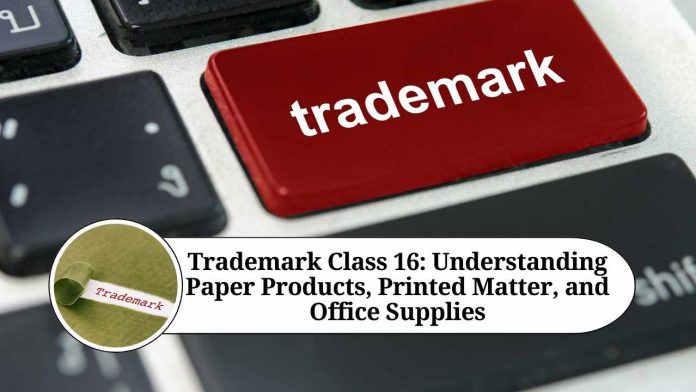Trademark Class 16: A Comprehensive Guide
If you’re planning to register a trademark, you may already know that trademarks are classified into 45 different classes according to the Nice Classification system. Each class represents a specific category of goods or services, and it’s important to choose the correct class for your trademark application. In this blog post, we’ll focus on Trademark Class 16 and provide a comprehensive guide to the types of goods it covers.
What is Trademark Class 16?
Trademark Class 16 is one of the 45 classes of goods and services that trademarks can be registered under. It includes a wide range of paper products, printed matter, and office supplies. Essentially, it covers anything that is printed or written on paper, cardboard, or other materials.
Goods Covered under Trademark Class 16
- Paper and cardboard This category includes all types of paper and cardboard, such as writing paper, printing paper, tracing paper, envelopes, cardboard boxes, and packaging materials made of paper or cardboard.
- Printed matter This category includes all types of printed matter, such as books, newspapers, magazines, brochures, pamphlets, posters, and maps.
- Stationery and office supplies This category includes a wide range of stationery and office supplies, such as pencils, pens, erasers, rulers, staplers, hole punches, paper clips, adhesive tapes, writing pads, diaries, organizers, and calendars.
- Artists’ and drawing materials This category includes a wide range of artists’ and drawing materials, such as paints, crayons, pencils, markers, drawing boards, canvas, brushes, and easels.
- Photographs and photographic products This category includes photographs, photographic prints, photographic albums, and photographic frames.
- Greeting cards and printed invitations This category includes all types of greeting cards, invitations, and announcements, including wedding invitations, birthday cards, Christmas cards, and thank-you cards.
- Packaging and wrapping materials This category includes packaging and wrapping materials made of paper or cardboard, such as bags, boxes, and wrapping paper.
- Printed publications This category includes printed publications, such as books, magazines, newsletters, newspapers, and periodicals.
- Printed instructional and teaching materials This category includes printed instructional and teaching materials, such as textbooks, workbooks, teaching manuals, and educational charts.
- Paper goods and printed matter not included in other classes This category includes all other paper goods and printed matter that are not included in other classes.
Why is it important to register under the correct class?
Choosing the correct class for your trademark application is crucial, as it determines the scope of protection your trademark will have. If your trademark is registered in the wrong class, it may not be protected for the goods or services that you are actually offering. This means that someone else could use your trademark for the same or similar goods or services, and you would not be able to take any legal action against them.
Additional goods covered under Trademark Class 16:
- Printed patterns This category includes all types of printed patterns, such as textile patterns, wallpaper patterns, and designs for clothing and footwear.
- Decals and stickers This category includes all types of decals and stickers, such as vinyl stickers, bumper stickers, and window decals.
- Paper and cardboard products for household use This category includes paper and cardboard products for household use, such as paper towels, napkins, tablecloths, and disposable plates and cups.
- Office requisites, except furniture This category includes all types of office requisites, such as rubber stamps, ink pads, folders, binders, and file boxes.
- Printed certificates and diplomas This category includes all types of printed certificates and diplomas, such as academic certificates, diplomas, and awards.
- Cheque books and cheque forms This category includes all types of cheque books and cheque forms, such as personal and business cheque books.
- Printed matter and publications for advertising purposes This category includes all types of printed matter and publications for advertising purposes, such as brochures, leaflets, flyers, and posters.
- Writing instruments This category includes all types of writing instruments, such as pens, pencils, markers, and highlighters.
Why is it important to register a trademark?
Registering a trademark is important because it gives you exclusive rights to use your trademark in connection with the goods or services you provide. This means that no one else can use your trademark for the same or similar goods or services without your permission. Registering a trademark also makes it easier to take legal action against infringers who use your trademark without your permission.
Trademark registration also adds value to your business by creating a valuable asset that can be licensed or sold. It also helps to protect your brand reputation by preventing others from using your trademark in connection with inferior or substandard goods or services.
Conclusion
In conclusion, choosing the correct class for your trademark registration is important to ensure that your trademark is properly protected. Trademark Class 16 covers a wide range of paper products, printed matter, and office supplies, and understanding the goods covered under this class can help you choose the correct class for your trademark application.
Read more useful content:
Frequently Asked Questions (FAQs)
- What is Trademark Class 16?
Trademark Class 16 is one of the 45 classes of goods and services that trademarks can be registered under. It includes a wide range of paper products, printed matter, and office supplies.
- What are some examples of goods covered under Trademark Class 16?
Some examples of goods covered under Trademark Class 16 include paper and cardboard, printed matter, stationery and office supplies, artists’ and drawing materials, greeting cards and printed invitations, and packaging and wrapping materials.
- Why is it important to choose the correct class for a trademark application?
Choosing the correct class for a trademark application is important because it determines the scope of protection your trademark will have. If your trademark is registered in the wrong class, it may not be protected for the goods or services that you are actually offering.
- How do I determine which class to register my trademark under?
You can determine which class to register your trademark under by reviewing the Nice Classification system and identifying the class that corresponds to the goods or services you offer.
- Can I register my trademark in multiple classes?
Yes, you can register your trademark in multiple classes if you offer goods or services that fall under different classes.
- How long does a trademark registration last?
A trademark registration lasts for 10 years from the date of registration, and can be renewed for subsequent 10-year periods.
- What is the process for trademark registration?
The process for trademark registration typically involves conducting a trademark search, filing a trademark application with the appropriate government agency, and waiting for the application to be examined and approved.
- Can I use my trademark before it is registered?
Yes, you can use your trademark before it is registered, but your rights to the trademark may be limited until it is registered.
- What are the benefits of trademark registration?
The benefits of trademark registration include exclusive rights to use the trademark in connection with the goods or services you provide, the ability to prevent others from using the trademark without permission, and the creation of a valuable asset that can be licensed or sold.
- What is the cost of trademark registration?
The cost of trademark registration varies depending on the country or region in which you are registering your trademark. In general, the cost includes filing fees, examination fees, and registration fees.




















